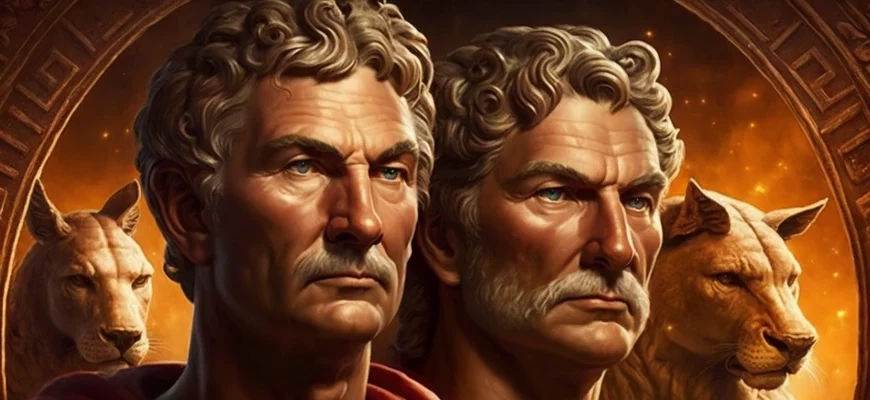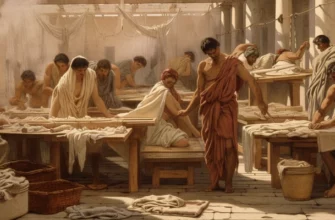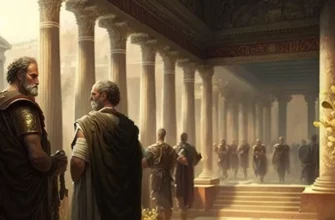The legends about the founding of Rome are a key element of Roman mythology and history. Let’s take a closer look at the legends about the founders of the city, Romulus and Remus, their conflict, and the founding of Rome. We will also examine the legend of the crow that showed Romulus where to found the city and the myth of the seven hills, which tells of the difficulties faced by the first inhabitants of Rome. These legends are an important part of Rome’s cultural heritage and reflect important elements of the city’s mythology and history. The historical accuracy of these legends is questionable, but they are essential for understanding Rome’s cultural heritage and history.
- Romulus and Remus: the legendary founders of the city
- The story of the upbringing of Romulus and Remus
- The conflict between Romulus and Remus
- The death of Remus and the founding of Rome by Romulus
- The name of the city: the legend of Romulus and the crow
- The myth of the seven hills: how the first inhabitants adapted to life
- Final thoughts: the importance of legends for Rome’s cultural heritage
Romulus and Remus: the legendary founders of the city
Romulus and Remus are the main characters in the legends about the founding of Rome. According to one version, the brothers were the sons of the god Mars and the grandsons of the goddess Venus.
When Romulus and Remus were children, they were thrown into the Tiber River, but they were rescued and raised by a she-wolf. Later, when they grew up, they founded a settlement on the Palatine Hill, but due to a conflict between the brothers, Romulus killed Remus and became the sole ruler of the city.
This legend tells of brotherly love, conflict, and cruelty, which became important elements of Roman history. There is also another version of the legend in which Romulus and Remus founded Rome together, but Romulus was recognized as the founder of the city.
Although the historical accuracy of these legends is questionable, they reflect important elements of Roman mythology and history, and emphasize the importance of brotherly love and solidarity in the founding of the city.
The story of the upbringing of Romulus and Remus
According to legend, Romulus and Remus were nursed by a she-wolf on the banks of the Tiber River. One day, they were found by a farmer named Faustulus, who decided to take them into his home and raise them as his own sons. Faustulus taught the brothers crafts and weaponry, which would prove useful to them in the future.
Later, Romulus and Remus decided to found their own city and chose the Palatine Hill as its location. When a dispute arose between them over where exactly to found the city, Romulus killed Remus and became the sole ruler of Rome.
This legend tells of the importance of education and training, which helped Romulus and Remus found the city and be successful. In addition, this legend emphasizes the importance of weapons and skills, which became key elements of Roman culture and history. However, the historical accuracy of these legends is still a subject of debate among historians.
The conflict between Romulus and Remus
The legend of the founding of Rome is associated with a quarrel between the twin brothers Romulus and Remus over the location of the city’s foundation. According to legend, Romulus chose the Palatine Hill as the site for the city, while Remus chose the Aventine Hill. The conflict between the brothers intensified, and they decided to settle the dispute through signs from the gods.
Romulus took his place on the Palatine Hill and watched for signs. Remus, who was on the Aventine Hill, saw six oxen and thought it was a sign of victory for him. But Romulus saw 12 oxen on his hill, which meant greater support from the gods. Romulus declared his victory and founded the city of Rome on the Palatine Hill.
This legend tells how a dispute can be resolved through signs from the gods. It also points to the importance of decisions made with divine intervention in shaping the history of Rome. However, in reality, most historians believe that this legend is a myth that reflects the religious beliefs of the Romans and their preference for resolving disputes through divine intervention.
The death of Remus and the founding of Rome by Romulus
Another legend about the founding of Rome is associated with the death of Remus. According to this legend, during the consecration ceremony of the new wall surrounding the future city, Romulus answered Remus’ question about the size of the city. This led to a quarrel between the brothers, during which Romulus killed Remus.
Romulus was surprised by his action and became sad, but he decided to continue building the city. He declared himself the sole ruler of the city, which he named after his brother—Rome. He became the first king of Rome and founded the Roman Empire, which existed for the next three centuries.
This legend shows the complexity of the relationship between the brothers and reflects the tragic situation that led to Remus’ death. It also tells how Romulus became one of the most important figures in the history of Rome thanks to his willpower and determination. However, in reality, this legend is only a myth that reflects the religious beliefs and cultural values of the Romans.
The name of the city: the legend of Romulus and the crow
One of the most famous legends about the founding of Rome is associated with the sign of a crow that appeared before Romulus while he was searching for a place for a new city. According to this legend, Romulus and his brother Remus were thrown into the Tiber River by their mother, who feared their father. They survived and were rescued by a crow that fed them milk.
When Romulus and Remus grew up, they decided to found their city on the banks of the Tiber. Romulus chose seven birds to perform a prophetic ceremony, but Remus appeared with an eighth bird. Romulus considered this a sign of divine wrath, but Remus insisted that his sign meant that he should become the ruler of the future city.
This led to a conflict between the brothers, which ended in tragedy. Romulus killed Remus and declared himself the sole ruler of the future city. He named it Rome in honor of his brother and became the first king of Rome.
This legend of Romulus and the crow tells of the belief in prophetic signs and divine will, which were considered important to the Romans. It also reflects the complexity of the relationship between the brothers and shows how religious beliefs influenced political decisions in the Roman Empire.
The myth of the seven hills: how the first inhabitants adapted to life
The legend of the seven hills is one of the most famous stories about the founding of Rome. According to this legend, the first inhabitants of Rome, who arrived at the place where Rome would later appear, found themselves on seven hills. These hills proved to be the ideal location for the defense and development of the city.
The first inhabitants of Rome were shepherds and farmers who found refuge on the hills. They used these hills to protect themselves from floods and enemy attacks. Over time, as the city grew, these hills became the foundation for the development of Rome.
The legend of the seven hills reflects the adaptation of the first inhabitants to life in a new place and shows how important it is to find a suitable location to ensure the safety and development of a city. It also shows how Rome’s mission changed over time, from protection against danger to becoming one of the greatest powers of the ancient world.
Final thoughts: the importance of legends for Rome’s cultural heritage
The legends about the founding of Rome are of great importance for the city’s cultural heritage. They not only tell the story of Rome’s founding, but also help to preserve its cultural and historical heritage.
These legends convey not only factual information about events, but also the cultural and moral values that were important to the first inhabitants of Rome. They have also become an important part of Rome’s national identity.
Although many legends about the founding of Rome are fantastical in nature, they are an integral part of the city’s cultural heritage. They are preserved and passed down from generation to generation and have become symbols of Rome’s culture and history.








